Contents
Clematis are very beautiful and responsive perennial flowering vines. They are planted to please the eye for many years, so it can be a shame when plants suffer from diseases and pests and may even die if urgent measures are not taken in time. From the article you can learn about the symptoms of clematis damage by various pests and diseases, with photos that will help you recognize this or that problem in time. It will also talk about prevention and ways to deal with a particular problem.
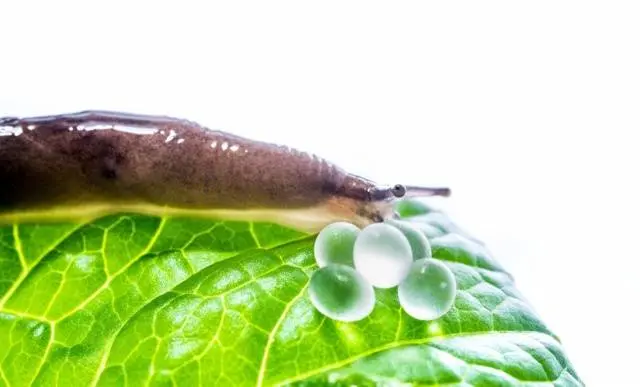
Problem prevention
Most often, pathogens and pests attack weakened plants, so it is very important to choose suitable clematis varieties for your region and carry out competent agrotechnical care for them.
Clematis health monitoring should begin from the moment the planting material is purchased. If possible, it is necessary to carefully examine the roots of clematis so that they do not have thickenings, which can later turn out to be such dangerous pests as root-knot nematodes.
The leaves should not have spots, holes and other mechanical damage indicating possible diseases.
For the prevention of numerous fungal diseases (fusarium, gray rot, verticillosis), it is advisable to soak the root system of clematis for half an hour in a solution of the Maxim fungicide before planting in a permanent place. To obtain a working solution, 4 ml of the drug (1 standard ampoule) is diluted in two liters of water.
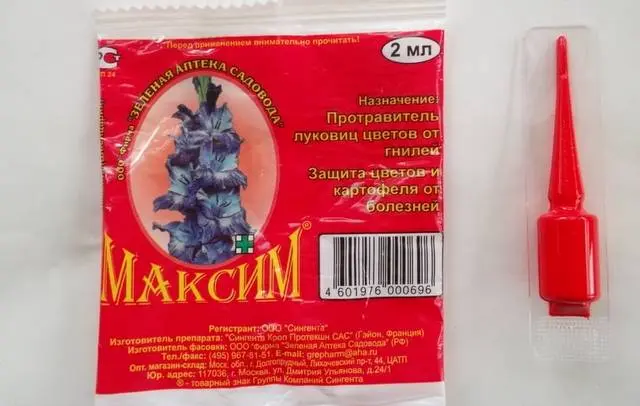
In the future, weakened clematis plants, in addition to top dressing, it is desirable to treat several times per season with immunostimulating drugs, such as Immunocytophyte.
And, of course, the main preventive measure against diseases and pests is the strict observance of all agronomic requirements when planting clematis and further caring for it.
Pests and ways to deal with them
Clematis has many enemies not only from the insect world, but also among worms and even mammals. All of them are capable of not only damaging or completely destroying the green parts of plants and their roots, but also carrying dangerous diseases and viruses.
aphid
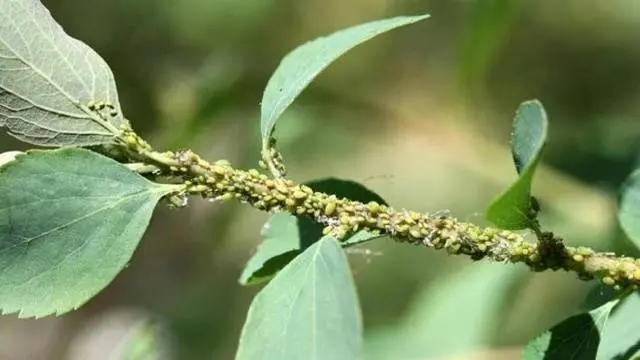
The most common pest in the garden, which is probably familiar to every gardener and gardener. Several thousand species of aphids are known in nature, but black, green and brown aphids are the most common in our gardens. Adult insects and their eggs are very small – about 2,5 mm in length. In autumn, they usually lay their eggs on clematis, and with the arrival of spring heat, they begin active life, sucking the juice from young shoots and causing them to dry out and die. The peak of their vital activity usually occurs at the very beginning of summer. Feeding on the green juice of clematis, pests secrete a sticky sweetish liquid, which can also be used to determine the aphid invasion of plants.
With the beginning of growth, the very tops of young clematis leaves and their reverse side should be regularly inspected for the accumulation of these pests. In spring, pests cannot yet move on their own – ants contribute to their movement. And closer to summer, when their number increases exorbitantly, in order to feed on newly born individuals, wings appear and they acquire the ability to move to neighboring plants.
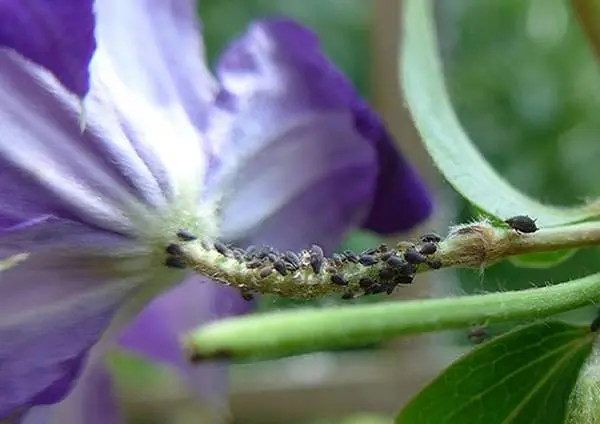
Hence the conclusion – the sooner you track the appearance of aphids on clematis and destroy it, the easier it will be for you later.
To combat this pest, you can use a variety of methods:
- Mechanical – destruction by hand or washing with a jet of water with small amounts of pests.
- Biological– many insects (ladybugs, lacewings, wasps), as well as birds (sparrows, tits, kinglets, linnets) eat aphids with pleasure. You can also plant some plants whose smell repels pests: onions, garlic, feverfew.
- People’s – the simplest and most effective remedy for this pest is a solution of liquid soap and sunflower oil in water (2 teaspoons of soap and 2 tablespoon of oil for 1 glasses of water). For spraying against aphids, infusions of garlic, tomato leaves, onion peel, horseradish, wormwood, hot pepper are also used.
- chemical – easily destroys aphids by spraying with any of the modern insecticides. It is safer to use fitoverm – since it is made on a biological basis. (2 ml per 0,25 l of water).
spider mite
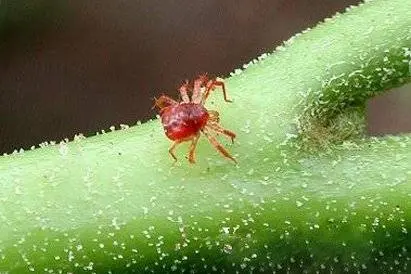
Clematis can suffer from three varieties of spider mites, and only one of them forms a web on leaves and shoots. In the initial period of infection, clematis leaves are covered with barely noticeable yellow specks, especially on the underside, then the affected areas of the leaves become discolored and dry. The pests themselves are so microscopic that it is impossible to see them with the naked eye.
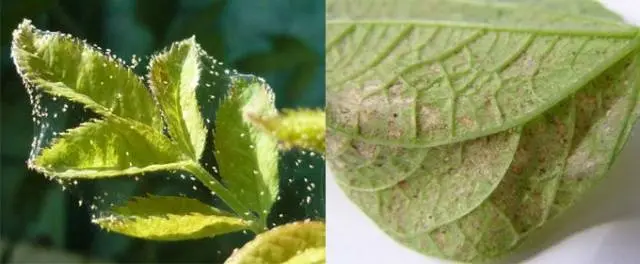
The invasion of the spider mite is favored by hot and dry weather, which is why it appears on clematis, as a rule, in the middle of summer. It is already much more difficult to deal with this pest than with aphids. Usually, only systemic insecticides (acaricides) are effective, the treatment with which must be repeated 3-4 times per season. Of the mild biological, but less effective means, Fitoverm, Vertimek, Bitoxibacillin can be advised. If they did not help, then it is necessary to apply Akarin, Aktellik, Antiklesch.
As a preventive measure, the following folk remedy helps a lot: when dry and hot weather sets in, clematis can be sprayed with infusion of garlic (200 g per 10 liters of water).
Nematodes
Nematodes are roundworms, and they are able to parasitize the roots, shoots and leaves of clematis.
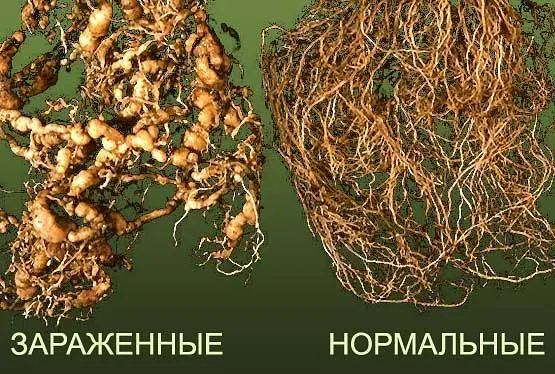
Especially dangerous for clematis is the gall nematode, which parasitizes on the roots, where thickenings of various sizes are formed – galls. As a result of their strong infection, young clematis may lag behind in development, leaves become discolored, lose turgor, and plants may even die. In adult plants, decorativeness is significantly reduced (leaves, flowers become smaller, plants do not grow to the required height).
But clematis can also infect other types of nematodes – strawberry and chrysanthemum, which damage leaves, stems and flowers.
These pests are especially common in the southern regions. No effective way to deal with nematodes has been identified to this day. It is only necessary to carefully examine the planting material and all plants that are under suspicion, or throw it away, or try to treat the roots with hot water at a temperature of + 50 ° C.
Mature plants are only partially oppressed by nematodes and can even bloom normally with additional regular top dressing.
In the place where clematis affected by nematodes were dug out, clematis cannot be planted again for 3-4 years.
Planting plants such as calendula, marigold, dill, coriander, watercress and mustard clean the soil well from nematodes.
As a mulch, you can use chopped wormwood and mint – these herbs repel nematodes.
fenestrated moth
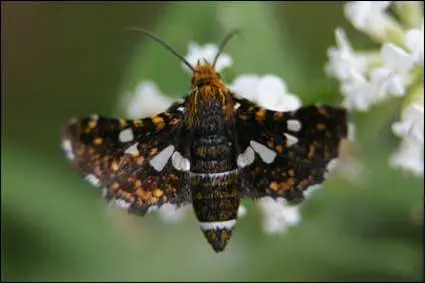
The caterpillars of this small triangular butterfly are capable of causing significant damage to the leaves and flowers of clematis in the middle of summer. In this case, the tips of the leaves are folded into a tube. Caterpillars are yellow-brown, small with warts all over the body.
The fight against this pest consists in spraying clematis with any insecticide, for example, Fitoverm, Vertimek, Actellik and others.
Moth real small
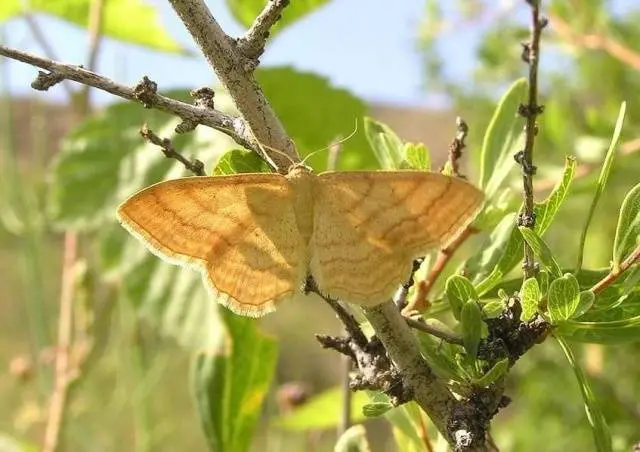
A butterfly from the family of moths with bluish-green wings begins to fly from June and feeds, including on clematis plantings, throughout the summer. Light green caterpillars with a dark back become especially active in the middle of summer. Green pupae can be found between the leaves.
To minimize the harm caused by these pests, it is enough to collect them by hand and destroy them in early summer. Of the biologically effective preparations for protecting clematis from leaf-eating pests, Agrovertin or Bitoxibacillin can be recommended.
Mealybug
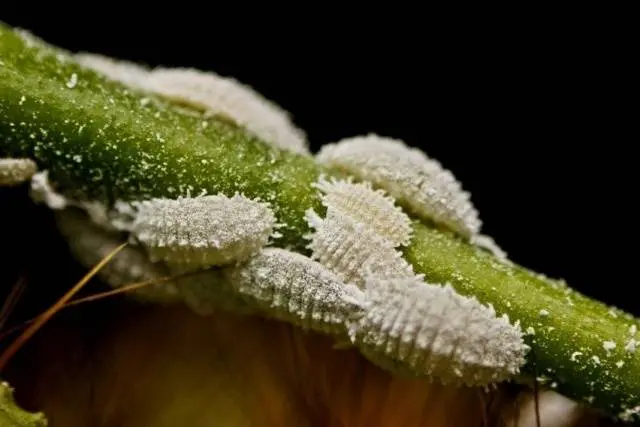
This pest loves warmth, so it is much more common in greenhouses, greenhouses and gardens in the southern regions. In clematis, it often damages the bases of the shoots, as well as the leaves and the shoots themselves. The body of the worm is covered with white waxy secretions, so it is easy to distinguish it.
The most effective drug for the fight against mealybugs is Aktara. This is a systemic insecticide that you can simply shed on a clematis bush and the ground around it (dilute 1 to 5 g of powder in 10 liters of water). Repeat the treatment after 1-2 weeks. As a result, the plant sap will become poisonous to pests, they will not be able to eat and will die.
With small accumulations of this pest, it is enough to wash the bases of the clematis stems and other places of its concentration with soapy water.
Slugs and snails
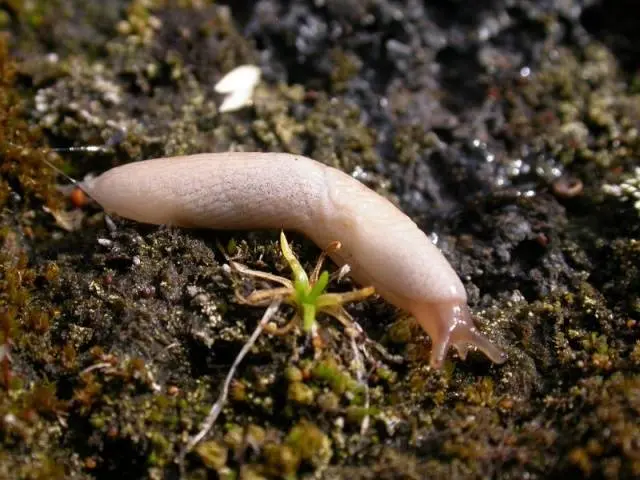
Several varieties of snails and slugs begin their destructive activity of eating clematis shoots starting in spring, when the weather is warm.
If these pests manage to damage the buds in the center of tillering, then the development of the entire bush may stop. In addition, through wounds, the plant can easily become infected with various fungal infections.
Pests hide under the wide leaves of weeds, so it is advisable to keep the ground under clematis always cleared.
To combat snails and slugs, sprinkling with wood ash, lime, superphosphate is often used, but these agents are not very effective.
It is safer to scatter Metaldehyde granules (30-40 g per square meter) over the soil surface.
Bedbugs
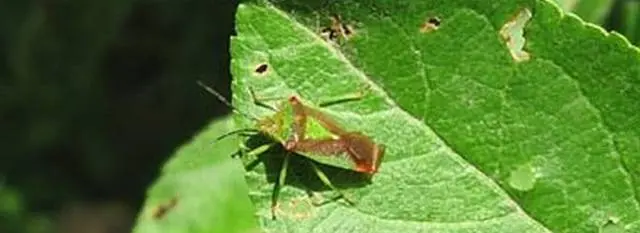
The garden green bug begins its activity in May and ends around August. It is clearly visible to the eye, reaches a length of 3-4 mm. It is usually found on the underside of young leaves. As a result of its activity, spots appear on the leaves and they dry out. At the ends of the shoots of clematis, the female pest lays eggs, as a result, the shoots stop growing and stop blooming.
Clematis can be saved by double treatment with any insecticide.
Shchitovka
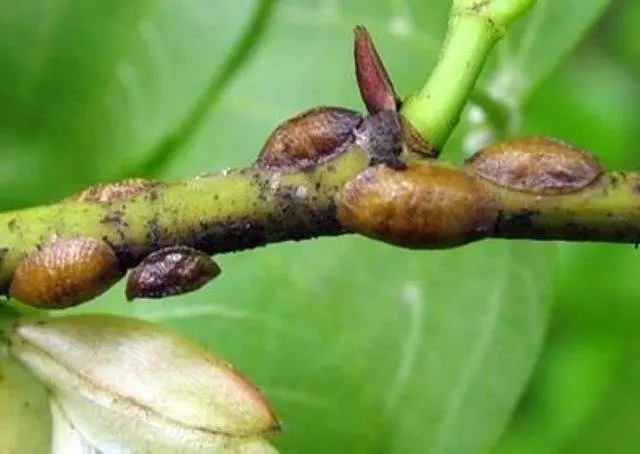
These pests, as well as the mealybug, most often live in the southern regions and in greenhouses. Scale insects are small insects covered with a kind of shell, usually motionlessly stuck to the leaves and stems of clematis.
With large accumulations of scale insects, they secrete a sweetish liquid, which is best removed along with the pests themselves using a 30-40% alcohol solution or a 4% solution of potassium soap.
For the final destruction of pests, it is advisable to shed clematis with Aktara’s solution, diluted in the same proportions as for the fight against mealybugs.
Medvedki
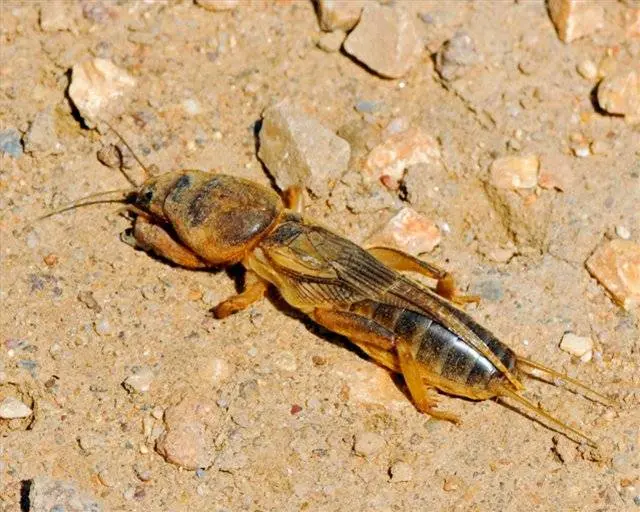
These insect pests dig long passages and burrows underground, while damaging the root system of plants. The activity of a bear can be especially dangerous for newly planted young clematis.
One of the effective ways to combat this pest is to pour a water-soap-oily solution into its holes (10-15 g of any soap and 20 tablespoons of vegetable oil per 2 liters of water). As a result, the bear suffocates and either dies underground or goes outside, where it is destroyed.
Many pest control chemicals are currently sold in garden stores, and they can also be used to protect clematis. And you can use an environmentally friendly tool – Metarizin, which is based on spores of a fungus that causes the death of a bear.
Mice, rats
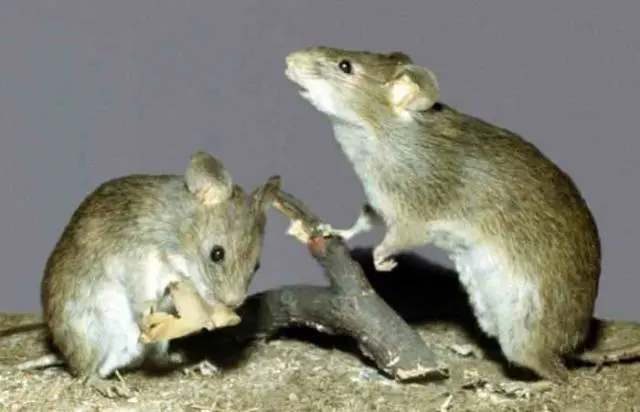
Rodents can cause significant damage to clematis plantings, especially in winter.
To protect clematis from mice and rats, poisoned baits are laid out under shelters for the winter. For rats, it is better to use bags, and for mice, poisoned grain placed in a piece of horizontal drainage pipe.
Fungal diseases, prevention and treatment
Among the diseases, the greatest danger to clematis is wilting, which can be caused by three types of fungi: Verticillium, Fusarium and Phomopsis.
Wilt or verticillium wilt
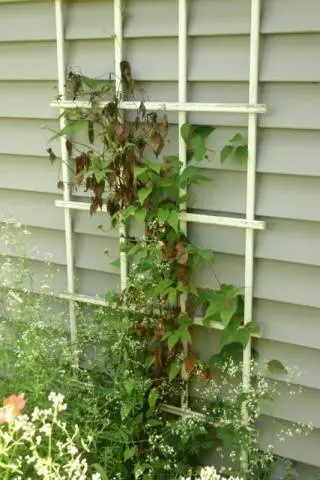
Most often, the term wilt itself is associated with verticillium wilt, but in the case of clematis, it often means any wilting of clematis lashes caused by one of the above fungi. Shoots lose turgor, wither, blacken and dry out. This process can take from several hours to several weeks.
A hundred years ago, these diseases were so unknown and therefore terrible that the very existence of clematis was at one time under threat, thanks to the invasion of disease-causing fungi. Later it turned out that they are especially activated in a humid and cool environment, so clarifications were made to the agricultural technique for growing clematis. At the moment, quite effective fungicides have also been invented, for example, Previkur, the use of which will help protect clematis from these diseases.
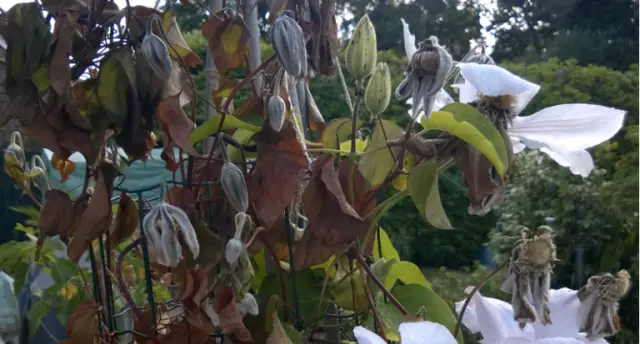
Of particular danger of infection is the early spring period, when humidity is everywhere very high. To protect clematis, it is recommended to shed the bushes in the spring with a solution of Previcur (25 ml per 10 liters of water).
Phomopsis wilt
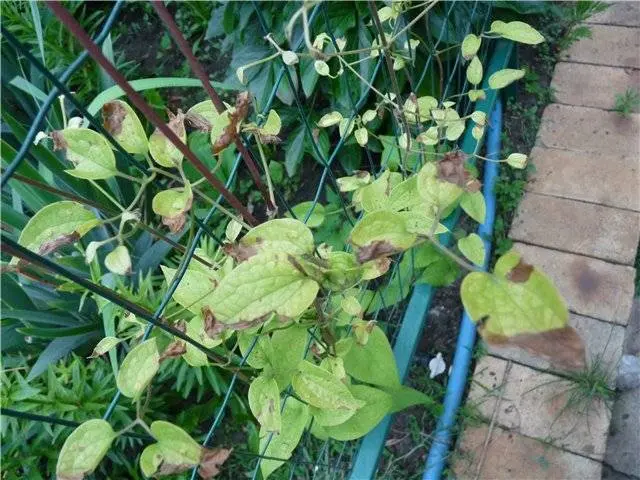
Signs of clematis damage by this disease appear in May-June on individual leaves growing at the very surface of the earth – rounded yellowish-brown spots that quickly grow over the entire surface of the leaf. As a result, the leaves turn dark and dry.
To protect clematis from this disease, it is urgent to cut off all damaged leaves, and shed the bushes with Previcur’s solution.
Fuzarioz

Signs of Fusarium disease usually appear later, in June-July. Weakened and old shoots are the first to suffer. Infection of clematis usually occurs in the lower part of the shoot, and the entire shoot from the top begins to dry out at once. Cutting stems and leaves down to healthy tissue and treating with Previkur usually helps save the rest of the plant.
Rust
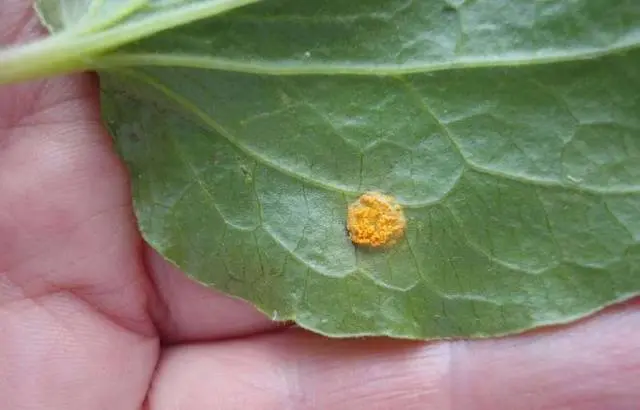
As a result of the activity of the fungus Aecidium clematidis DC in the spring, on the shoots and leaves of clematis, small orange swelling-spots in the form of pads, consisting of a powder mass, can sometimes be observed. These are spores of a fungus that causes rust, a disease that can cause leaf death and shoot deformation.
For the purpose of prevention, all weeds around are destroyed, and especially wheatgrass, on which the causative agent of this disease overwinters, as well as clematis shoots affected by the fungus. Bushes are treated with 1-2% Bordeaux liquid or other copper-containing preparation.
Gray mold
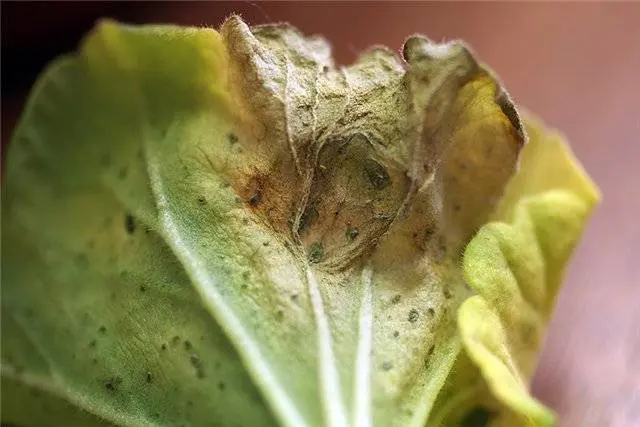
This disease is most often manifested in cool and rainy summers. Stagnation of air and overfeeding with nitrogen fertilizers contribute to the spread of the disease. It manifests itself as a gray fluffy coating on leaves, shoots, clematis flowers. Spores of the fungus are able to be carried by the wind and persist on plant debris.
You can try to fight this clematis disease by spraying and spilling the bushes with a biofungicide – Fitosporin. If it does not help, then treat the clematis with Previkur.
Mučnistaâ rosa
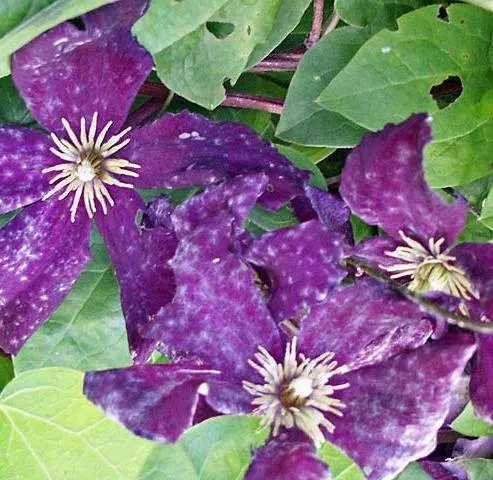
Powdery mildew is especially common on clematis in the southern regions and the peak of its harmfulness occurs in the hottest and sunniest months – July, August. The disease manifests itself in the form of a fluffy white coating on leaves, shoots, flowers and even seeds. Damaged places are deformed, the development and flowering of clematis stops.
To combat the disease, treatment with any fungicide is used. From folk remedies, the following are considered effective: a solution of mustard powder (2 tablespoons per 10 liters of water), a solution of soda ash (40 g per 10 liters of water), a mixture of ethyl alcohol and salicylic acid.
Ascochitosis
A separate group of diseases is made up of fungi, the defeat of which causes spots of various shapes and colors on the leaves of clematis. If these diseases are left untreated, then clematis will begin to develop worse, bloom and leave very weakened before winter. Most of these clematis diseases are fairly easy to deal with with a double treatment with any copper-containing preparation. If you do not feel like using chemicals, try Fitosporin or Alirin-B in combination with Gamair (1 tablet of each drug per 1 liter of water).
Ascochitosis causes dark brown spots, the development of the disease leads to the appearance of holes in the places of damaged tissues.
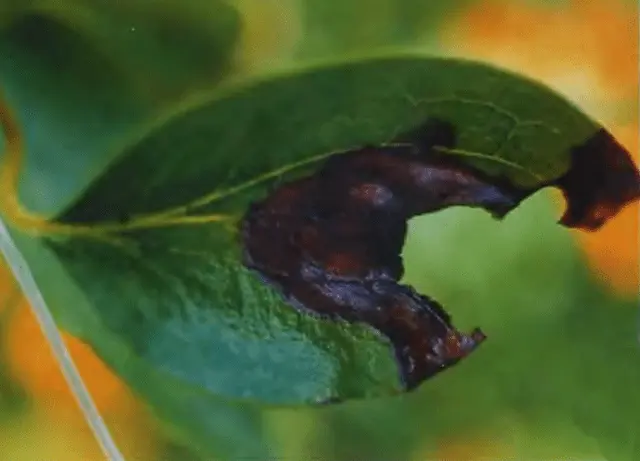
Alternaria
As a result of this disease, brown spots also appear, which quickly turn black and everything ends with leaf necrosis.
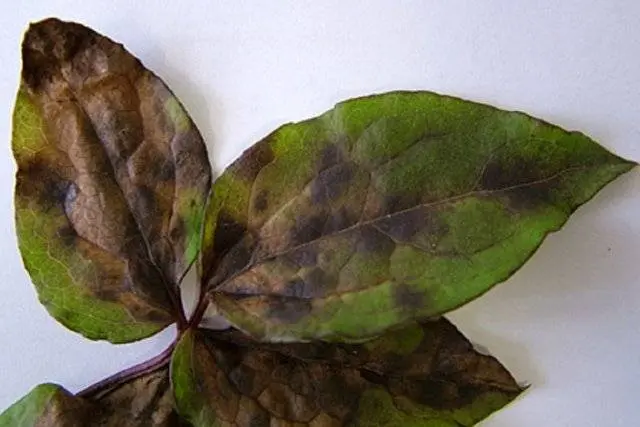
septoriosis
This disease often manifests itself in the form of gray spots with a red border.
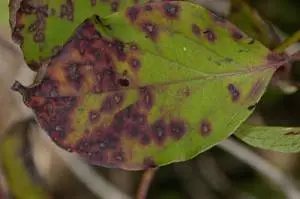
Cylindrosporiosis
The result of this disease is usually spots on the leaves of clematis of an ocher, yellowish hue.
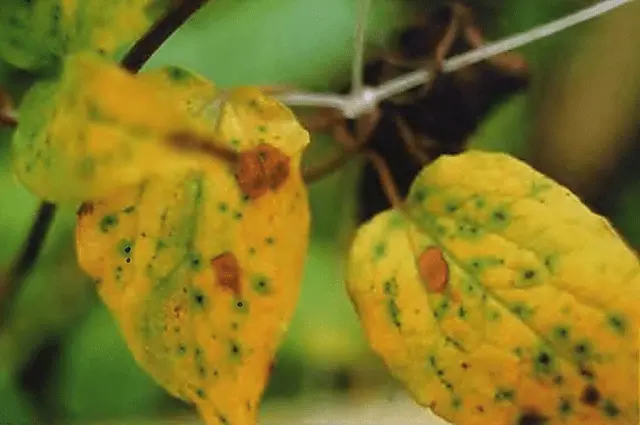
All damaged leaves must be removed from plants and destroyed before processing.
Viral diseases and their control
Viral diseases, fortunately, rarely visit clematis, but still they sometimes visit.
yellow mosaic
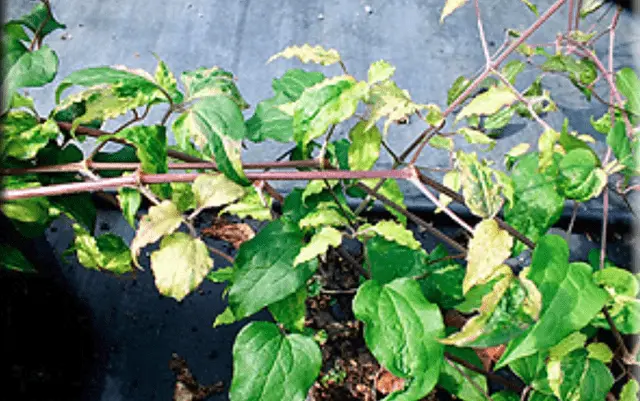
Several cases of clematis damage by yellow mosaic have been established. Viruses are spread by pests – aphids, mites, worms, so it is necessary to deal with them, first of all. And so far, effective methods of dealing with the viruses themselves have not been found.
Sick plants, unfortunately, will have to be destroyed, and all tools thoroughly disinfected.
Physiological damage
Clematis also has problems that are not related to diseases or pests, but rather depend on improper growth and care conditions.
colorless flowers
Often, as a result of a lack of heat or lighting, as well as improperly selected fertilizers, the sepals of clematis are only partially colored or completely colorless. Try to check if you are doing everything right in caring for your pets and, most likely, the flowers will soon please you with their usual color.
Reddened stems
As a result of extreme heat and drought, clematis shoots can turn red. In this case, they need to create shading and water more intensively.
Conclusion
Of course, among pests and pathogens there are many who want to feast on clematis and its parts. But it should be remembered that a strong plant with a good immune system is able to protect itself, but do not forget to periodically inspect the plants in order to notice bad symptoms in time and have time to take action.









